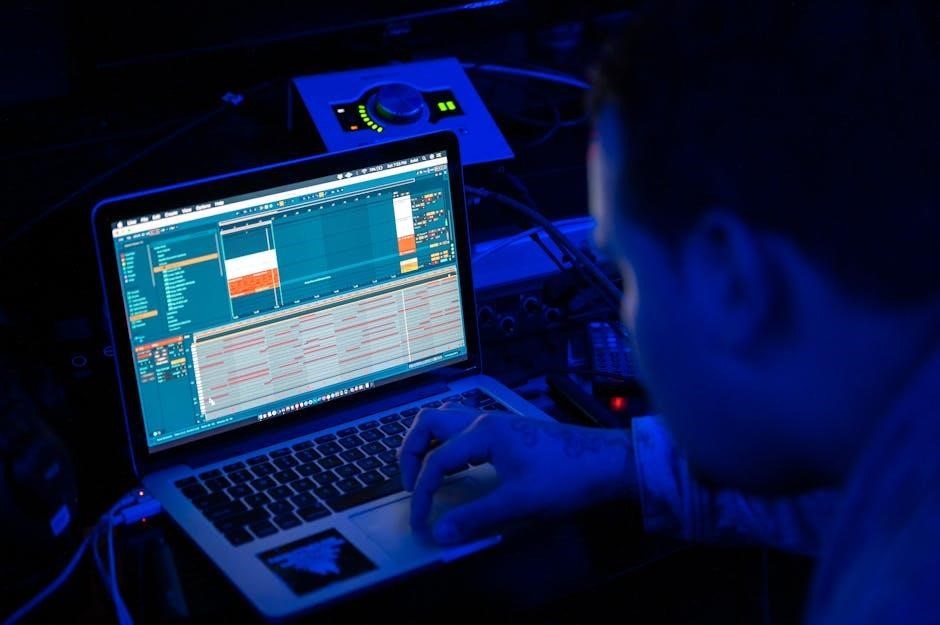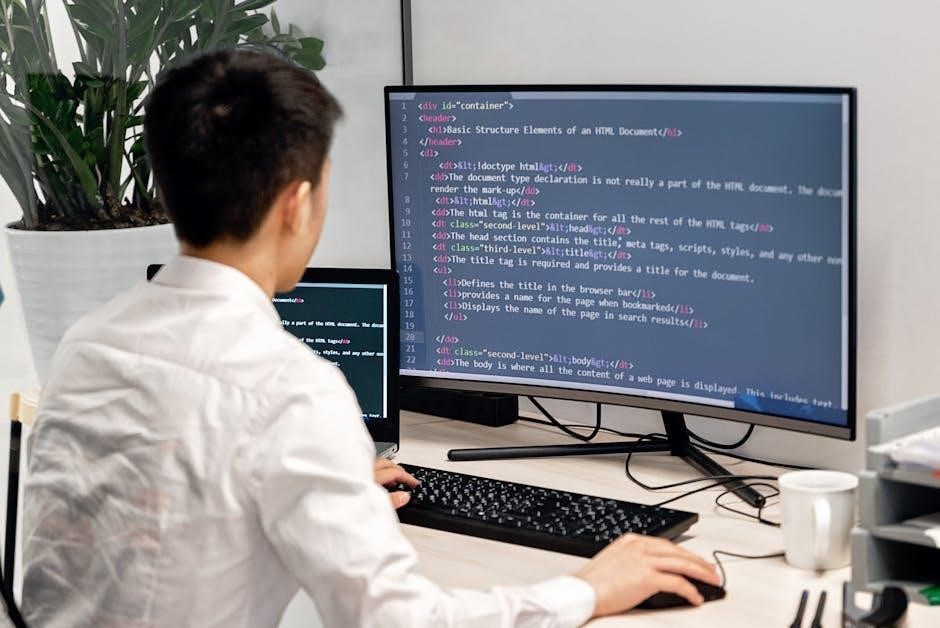
Behavioral interviews assess problem-solving skills and cultural fit by focusing on past experiences. They complement technical interviews, revealing how candidates handle challenges. STAR method is key.
Overview of Behavioral Interviews

Behavioral interviews focus on assessing a candidate’s past experiences to predict future performance. They emphasize storytelling, with questions like “tell me about a time you…” to reveal problem-solving skills, teamwork, and decision-making. Unlike technical interviews, which test coding abilities, behavioral interviews evaluate soft skills, adaptability, and cultural fit. Interviewers use structured frameworks, such as the STAR method, to gather detailed responses. This approach helps companies understand how candidates handle challenges, collaborate, and grow in real-world scenarios, making it a crucial part of the hiring process for software engineers.
Importance of Behavioral Interviews in Software Engineering
Behavioral interviews are crucial for evaluating how software engineers approach real-world problems, collaborate with teams, and adapt to challenges. They provide insights into a candidate’s problem-solving mindset, communication skills, and past experiences, which are vital for success in dynamic tech environments. Unlike technical interviews, which focus on coding skills, behavioral interviews reveal how candidates handle stress, prioritize tasks, and learn from failures. By understanding these traits, employers can identify candidates who align with company values and thrive in collaborative settings, leading to better hiring decisions and stronger team dynamics.

Preparing for Behavioral Interviews
Research the company, practice common questions, and use the STAR method to structure responses. Review past experiences to showcase problem-solving skills and collaboration effectively.
Researching the Company and Role
Understanding the company’s mission, values, and culture is crucial for behavioral interviews. Research their recent projects and technologies to align your experiences with their goals. Review the job description to identify key skills and qualifications. Familiarize yourself with their products or services to demonstrate genuine interest. This preparation helps tailor your responses, showing how your background and skills match their needs. It also enables you to ask informed questions during the interview, showcasing your engagement and enthusiasm for the role.

Practicing Common Behavioral Questions
Practicing common behavioral questions is essential to ace interviews. Use the STAR method to structure your responses, ensuring clarity and conciseness. Review frequently asked questions like “Tell me about a time you overcame a challenge” or “Describe a team project you contributed to.” Prepare examples from your past experiences, highlighting your problem-solving skills and collaboration abilities. Mock interviews with peers or mentors can help refine your delivery. Focus on showcasing your thought process and how you align with the company’s values. This preparation builds confidence and ensures you can articulate your strengths effectively during the interview.

Common Behavioral Interview Questions for Software Engineers
Behavioral interviews for software engineers often include questions like “Tell me about a time you solved a technical challenge” or “Describe a project you led.”
Examples of Technical Behavioral Questions
Technical behavioral questions focus on problem-solving and past experiences. Examples include: “Describe a complex bug you fixed and your approach,” “How did you optimize a slow-performing system?” or “Tell me about a challenging algorithm you implemented.” These questions assess debugging skills, system design knowledge, and collaboration abilities. Interviewers seek specific examples that demonstrate technical expertise and critical thinking. Preparing for such questions involves reviewing past projects and practicing structured responses using the STAR method. Highlighting lessons learned and your role in team problem-solving is key to showcasing your technical leadership and adaptability.
Examples of Soft Skills Behavioral Questions
Soft skills questions focus on teamwork, communication, and problem-solving. Examples include: “Tell me about a time you had to collaborate with a cross-functional team,” “How do you handle conflicting opinions during a project?” or “Describe a situation where you had to explain a complex technical issue to a non-technical stakeholder.” These questions assess your ability to work with others, communicate effectively, and manage conflicts. Employers seek candidates who can thrive in team environments and demonstrate strong interpersonal skills. Be prepared to provide specific examples that highlight your adaptability, empathy, and leadership abilities.

Techniques for Answering Behavioral Interview Questions
Master techniques like the STAR method and structured storytelling to effectively answer behavioral questions. Practice articulating specific examples, focusing on your role and the outcomes achieved.
The STAR Method for Structured Responses
The STAR method is a powerful framework for answering behavioral interview questions. It stands for Situation, Task, Action, and Result. Start by describing the context of the situation, then outline the task you faced. Next, detail the specific actions you took to address it. Finally, highlight the outcome or results of your efforts. This method ensures clarity and conciseness, making your responses impactful. By focusing on your role and the results achieved, you demonstrate your problem-solving skills and contributions; Practice using STAR to structure your answers effectively, making it easier for interviewers to assess your qualifications and fit for the role.
Using Specific Examples from Past Experiences
Using specific examples from past experiences is crucial in behavioral interviews. It allows you to demonstrate your skills and problem-solving abilities in real-world scenarios. When answering, focus on challenges you faced, the actions you took, and the outcomes achieved. Be detailed and relevant, ensuring your examples align with the question. Avoid generic responses; instead, provide concrete stories that highlight your strengths. Interviewers use these examples to assess your cultural fit and problem-solving skills. By showcasing your past successes, you illustrate how you can contribute to future projects and teams. This approach makes your responses memorable and impactful.

Non-Verbal Communication in Behavioral Interviews
Non-verbal cues like body language, eye contact, and posture significantly impact impressions. Maintain open gestures, consistent eye contact, and confident posture to convey professionalism and engagement during interviews.
Body Language and Eye Contact
Maintaining positive body language is crucial during behavioral interviews. Sit up straight, keep your shoulders relaxed, and avoid crossing your arms, which can signal defensiveness. Use open gestures to emphasize points, showing confidence without exaggeration. Eye contact is equally important; it conveys honesty and attentiveness. Aim for consistent but natural eye contact, avoiding staring intensely or constantly looking away. These non-verbal cues help create a positive impression, reinforcing your verbal responses and demonstrating professionalism. Ensure your body language aligns with your words to build trust and rapport with the interviewer.

Tone of Voice and Confidence
Your tone of voice and confidence significantly impact your performance in behavioral interviews. Speak clearly and maintain a steady, professional tone to convey your ideas effectively. Avoid filler words like “um” or “uh,” as they can undermine your credibility. Confidence is key—project self-assurance without appearing arrogant. Practice your responses aloud to ensure a natural and assured delivery. A confident tone demonstrates your readiness for challenges and collaboration, which are essential for success in software engineering roles. Show enthusiasm for your work and maintain a positive demeanor throughout the conversation.

Follow-Up After the Interview
Following up after the interview is crucial. Send a thank-you note within 24 hours, restating your interest. If no update after a week, politely inquire about your application status.
Writing a Thank-You Note
A thank-you note is a professional courtesy that reinforces your interest in the role. It should be concise, personalized, and sent within 24 hours of the interview. Reference specific topics discussed, such as a project or challenge you resonated with, to show attentiveness. Express gratitude for the opportunity and reaffirm your enthusiasm for the position. Keep the tone professional yet genuine. This small gesture leaves a positive impression and demonstrates your commitment to the process. It also highlights your ability to communicate clearly and thoughtfully, traits valued in software engineering roles.
Following Up on the Status of Your Application
Following up on your application demonstrates professionalism and enthusiasm. Wait 7-10 business days post-interview before reaching out. Send a polite email to inquire about the status, referencing the interview and reiterating your interest. Keep the tone concise and professional, avoiding pushiness. This shows you value their time and are eager to contribute. If no response, consider a follow-up call. Persistence, when done respectfully, can leave a positive impression and keep you top-of-mind for hiring managers. It also reflects your ability to communicate clearly and maintain engagement.

Resources for Behavioral Interview Preparation
Utilize eBooks and PDF guides for structured advice. Platforms like Pramp and InterviewBit offer mock interviews. Practice with tools like LeetCode and Glassdoor to refine your skills effectively.
Recommended PDF Guides and eBooks
Download comprehensive PDF guides and eBooks to master behavioral interviews. These resources provide insights into common questions, sample answers, and strategies to showcase your skills effectively.
Topics include problem-solving techniques, communication tips, and cultural fit assessments. Popular titles like “Cracking the Coding Interview” and “Behavioral Interviews for Software Engineers” offer practical advice.
These guides help you understand interviewer expectations and refine your storytelling abilities. They also cover soft skills, team dynamics, and leadership experiences.
Use these materials to prepare confidently and leave a lasting impression during your interviews.
Online Platforms for Mock Interviews
Utilize online platforms like Pramp, InterviewBit, and LeetCode to practice mock interviews. These tools simulate real interview scenarios, helping you refine your responses to behavioral and technical questions.
Platforms like Pramp offer free coding challenges and mock interviews, while InterviewBit provides structured practice for both coding and behavioral rounds.
LeetCode includes mock interview features to test problem-solving skills under time constraints. These resources provide feedback and help you improve your performance. Regular practice on these platforms ensures confidence and readiness for actual interviews.